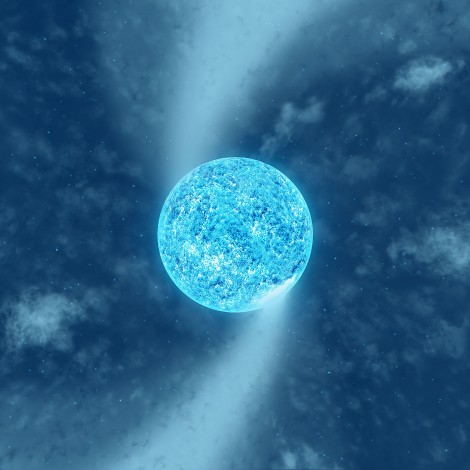
Spots on Supergiant Star Drive Spirals in Stellar Wind
Ohio Wesleyan Professor’s Program Contributes to New Astronomy Research

A Canadian-led international team of astronomers, including Ohio Wesleyan University professor Robert Harmon, recently discovered that bright spots on the surface of a supergiant star are driving huge spiral structures in the star’s stellar wind.
Their research was published recently in the Monthly Notices of the Royal Astronomical Society (MNRAS), widely recognized as one of the world’s leading astronomy journals.
Harmon, Ohio Wesleyan’s Perkins-Howard Professor of Physics and Astronomy, said his Light-curve Inversion program was used to make maps of the star’s surface showing the locations of bright spots.
“My program is usually used to map dark spots on stellar surfaces based on how a star’s brightness varies as the spots are carried into and out of our view by the star’s rotation,” Harmon said. “But I had intentionally written the program so that it could be readily modified to map bright spots instead. I was excited that the maps helped to show that the bright spots are driving the spiral structures in the wind. It’s very fulfilling to be part of a team of researchers that has given us important new insights into the physics of stellar winds.”
The research is significant because massive stars are responsible for producing the heavy elements that make up all life on Earth. At the end of their lives, these stars scatter the material into interstellar space in catastrophic explosions called supernovae. Without these dramatic events, our solar system would never have formed.
The new research utilized zeta Puppis, an evolved massive star known as a “supergiant.” It is about 60 times more massive than our sun, and seven times hotter at the surface. It is a single massive star moving through space at a velocity of about 60 kilometers per second – about 60 times faster than a speeding bullet.
The research was led by Tahina Ramiaramanantsoa, Ph.D. student at the Université de Montréal and member of the Centre de Recherche en Astrophysique du Québec; CRAQ.
The physical origins of the bright surface spots and the random brightness variations discovered in zeta Puppis remain unknown at this point, and will be the subject of further investigations.
Read the complete research announcement. Learn more about the Royal Astronomical Society. Explore Ohio Wesleyan’s Department of Physics and Astronomy.
Information provided by the Royal Astronomical Society is used in this article with permission.
Founded in 1842, Ohio Wesleyan University is one of the nation’s premier liberal arts universities. Located in Delaware, Ohio, the private university offers more than 90 undergraduate majors and competes in 23 NCAA Division III varsity sports. Through Ohio Wesleyan’s signature OWU Connection program, students integrate knowledge across disciplines, build a diverse and global perspective, and apply their knowledge in real-world settings. Ohio Wesleyan is featured in the book “Colleges That Change Lives” and included in the U.S. News & World Report and Princeton Review “best colleges” lists. Learn more at www.owu.edu.
